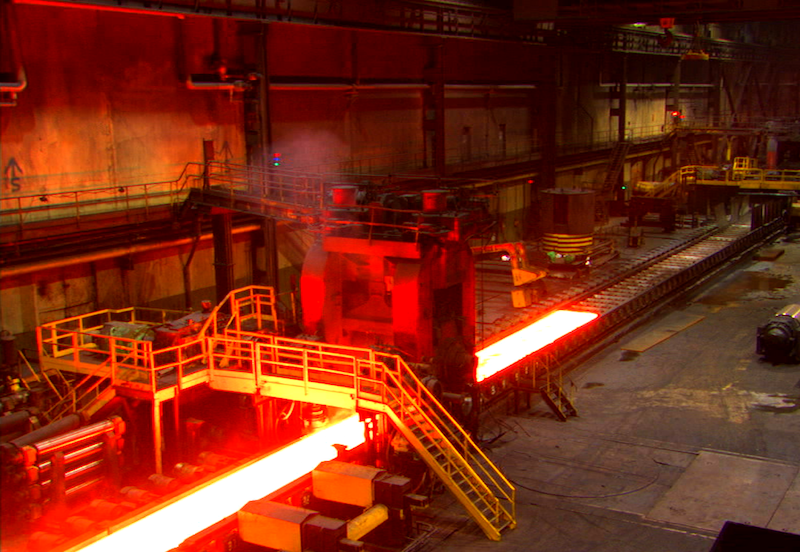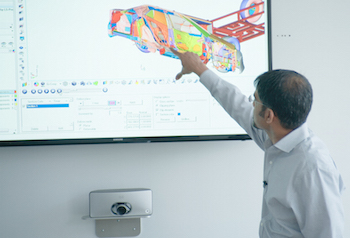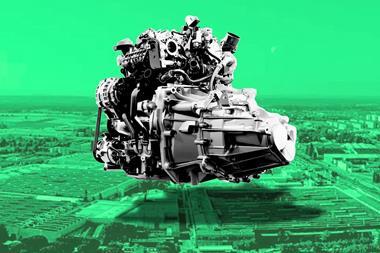ArcelorMittal’s Indiana Harbor steel mill has needed to change with the times. AMS paid a visit ArcelorMittal employs over 4,200 people at its Indiana Harbor facility, which has been the site of steel making for over 100 years. According to Wendell Carter, long-serving steel man, vice-president and general manager: “Indiana Harbor is the largest integrated steel-producing facility in North America with three blast furnaces (one of which is the largest in the continent) and a hot-strip mill, and offers a full range of products to customers in appliance, automotive and construction industries.” The plant is supplied with iron ore from the company’s Minorca, Minnesota, mine (35%) and Cleveland Cliffs through a contract agreement.
ArcelorMittal employs over 4,200 people at its Indiana Harbor facility, which has been the site of steel making for over 100 years. According to Wendell Carter, long-serving steel man, vice-president and general manager: “Indiana Harbor is the largest integrated steel-producing facility in North America with three blast furnaces (one of which is the largest in the continent) and a hot-strip mill, and offers a full range of products to customers in appliance, automotive and construction industries.” The plant is supplied with iron ore from the company’s Minorca, Minnesota, mine (35%) and Cleveland Cliffs through a contract agreement.
Carter notes that the plant’s current production capacity is 6.4m tons of slabs, down from 9m tons prior to the financial crisis of 2008. Since the economic downturn, the US steel industry has been reshaped and at Indiana Harbor there has been a push to develop the most important and productive assets. Part of this has involved a refocusing of the finishing operations with a move from two hot-strip mills to one.
Producing advanced steelsThe facility has seen an investment of $82m, which Carter says was mostly for a new caster. He adds that Indiana Harbor has become a leading producer of high-strength steel, supplying much of this to the automotive industry.An important development at the plant is MartINsite steel. This product offers steel strengths from 900Mpa up to a commercially available 1,700Mpa. Key to its production is the No.3 CAL line water quenching system, which has the high cooling rate needed to form MartINsite. Used in automotive intrusion-resistant applications (bumpers, door beams, rockers and roof rails), this steel can be cold-rolled or electro-galvanised.
No alloys are added in the BOF for steel used in automotive applications as the level of carbon present in the iron, around 4%, needs to be reduced to 0.035% in order to improve the formability of the finished steel
The vast buildings of No.3 steel mill include the Basic Oxygen Furnace (BOF), where molten iron is poured from the blast furnace into an iron ladle (distinguished by a spout). Then, in order to remove the sulphur content, powdered magnesium and lime are added. Through a chemical reaction, these combine with the sulphur which then floats to the surface as slag. The huge iron ladle is tilted forward, allowing the slag to be skimmed off using a mechanical rake. In the BOF, most of the impurities are refined out, then, depending on the grade of steel being produced, elements such as carbon, manganese, silicon, aluminium are added.

The BOF performs around 90% of the alloying process of the iron, then the Ladle Metallurgy Facility (LMF) ‘trims’ the temperature and chemistry, refining it further still. However, no alloys are added in the BOF for steel used for automotive applications as the level of carbon present in the iron, around 4%, needs to be reduced to 0.035% in order to improve the formability of the finished steel. The carbon content is reduced by a process of introducing oxygen into the molten iron.
Achieving greater refinement in the LMFIn the second part of the process, precise refinement of steel is carried out in the LMF based on customer requirements. The facility includes two ladle reheat furnaces and a vacuum de-gasser. The company has invested in an automated steel sample preparation system. A probe takes a sample steel ‘slug’ to examine the steel chemistry in greater detail; the analysis process, using computer modelling, takes just three minutes. From this, any adjustments to the batch of steel are made.
Additional investment has doubled the number of alloy bins to 18 and improved the efficiency of the alloy delivery system, allowing for greater accuracy when adjusting the steel chemistry. The steel is reheated using three-phase electrodes, alloys are then added as needed and the steel is stirred by means of an electromagnetic system. Using magnetic fields to churn the steel prevents any disturbance of the slag covering the surface, so that the molten steel beneath is not exposed to the oxidising air.
Following this process, the refined steel is transferred to one of two casters. The company has invested in upgrading the No.2 caster and this now uses the latest technology to improve efficiency and flexibility, including an advanced spray-cooling system for better crack control. It is said that this caster can now produce a wider range of steel grades. Here, the molten metal is poured into the copper-lined, water-cooled jacket in the caster, which creates a cooled outer skin on the metal as it progresses through a roller to form continuous (still very hot) steel slab. This hot slab is then cut to length and stored for processing in the hot-strip mill.
Reheating slabs in the hot-strip millAt the 80-inch hot-strip line (referring to the maximum 80-inch line width), the slabs are reheated to 2,300°F in a walking-beam furnace, then placed on the roller conveyor line that takes them through a number of stages. ‘Walking beam’ refers to how the heated slabs are ‘walked’ through the reheat furnace using a revolving beam. The technology improves the energy efficiency of the furnace and reduces surface deformation (important now, due to more demanding surface quality requirements from customers) compared with older pusher type furnaces.
The ‘Mighty 80’, as the line is known at Indiana Harbor, stretches for half a mile, along which the slabs go through a number of rolling and cooling stages in batches based on application for the steel and the required width. First, the roughing mill rolls the hot slab, taking the thickness down from 10 inches to 1.25 inches. In the finishing mill, the 1.25-inch slab is further reduced to the thickness required by the customer. This involves performing a series of rolling operations while carefully managing the temperature and the dimensions of the steel strip. The finished steel is then coiled and left to cool ready for transportation.
ArcelorMittal is celebrating the 50th anniversary of its R&D centre in East Chicago and this highlights how the steel-maker has positioned itself as a solution provider. As evident in the production operations at the steel mill, changing demands, greater market complexity and diversity of products, even for a single sector such as automotive, have meant that the products have become highly developed.
Part of the R&D centre features scaled-down versions of production processes used at the steel mill, such as furnaces, casting and a hot-strip line. These allow samples of any new steel grades to be produced in small batches but using essentially the same process as that used in high-volume production.
 ArcelorMittal's R&D branch is exploring new vehicle structures
ArcelorMittal's R&D branch is exploring new vehicle structuresNew vehicle structuresA number of development projects relating to automotive applications are also taking place. S-in motion is an ongoing programme developing lightweight vehicle structures. In the first phase, this was a joint project between research centres in France, Canada and the US, and focused on C-segment vehicles.
The study looked at all parts of the vehicle structure to determine if there were any stiffness or strength limitations in the steel components. From this, the company devised a ‘catalogue’ of 43 solutions for improving different areas of the structure. These include using greater amounts of press-hardened and advanced high-strength steels which together could offer weight reductions of up to 16% in BIW structures.
Focus on SUVs and EVsThe company says the lightweight S-in motion structures have been crash-tested at or above current safety standards, and that these solutions can be implemented by automotive manufacturers without any significant increase in production costs. The project is now focusing on light truck and SUV applications, and according to Gregory Ludkovsky, vice-president and head of R&D, the company is designing a completely new concept for electric vehicle (EV) structures.
Dent-resistant doorsAnother interesting development is a joint project on producing very lightweight, dent-resistant outer body panels. During the tour, AMS was shown a sample batch of door panels which had been specially stamped by the company’s lab in Europe. These were made of a very light gauge (0.5mm) high-strength steel which had been sprayed on the inside surface with a special reinforcing coating developed by a partner company. These were undergoing tests to determine the effectiveness of the coating when applied to different areas of the panel.
Other development areas include: the hot-dip coating lab, where coating processes can be tested on new steel grades; corrosion testing on different grades of steel for a number of applications and environments; and a weld lab testing the weldability of different steels, weld strength and spot weld-tip service life.





































